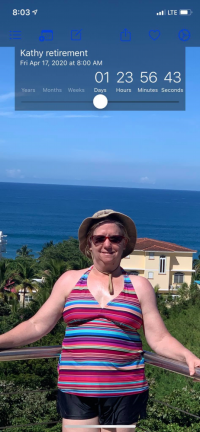Pandemic’s silver lining: a fitter lifestyle
Fitness. Some gained “the quarantine 15,” then shed “the Covid-19”




When Dolly Singh, 60, started working from home in March, at first it was kind of nice. Instead of waking up at 5:50 a.m. to drive from Chester, N.Y., to Parsippany, N.J., three times a week, she could sleep until 7, flip open the laptop at her side, and start her workday as an administrative assistant at Deloitte.
But her bathroom scale soon started telling a worrisome story. “I started eating, because the whole pattern got changed, you know?” Without the routine of working out at the gym in her office building three times a week, “I was either sitting and working or I was eating, or in the evening watching TV.”
By late May, she had added that notorious “quarantine 15” to her five-foot, three-inch frame. At 156 pounds, she felt low and didn’t want to see anyone. “I just felt there’s something wrong,” she said. “Because once you have the weight, all the numbers keep going up” – like blood pressure and cholesterol.
But the last thing she wanted to do was go on another diet. Over the years, she has tried SlimFast, a raw vegetable diet, “every damn thing on earth,” she laughed. “Once you lose weight, it always comes back. Once you go back to regular food, then again it comes back to you.”
Singh is far from alone. “So many of us have been affected mentally, emotionally by the pandemic, the loss of life, fear of illness, loss of job security, loss of jobs, the inability to exercise at gyms, to get out and be active and social,” said Dr. Alan Schaffer, a pulmonologist at Goshen Medical Associates who specializes in critical care, sleep, and obesity medicine. “The anxiety, the depression. I have found that many of my patients I see for weight management have put on weight during the pandemic. So I work with them about trying to get back on track, be encouraging, letting them know that weight management is not a linear process, it often has its successes and challenges.”
After lamenting her weight gain with a friend on the phone, Singh decided it was time to change things up. She remembers the exact day she started anew: May 27. She got up at 5:50, like she used to when commuting. Singh, who is Sikh, said her prayers and went for a morning walk around her quiet neighborhood.
That two-mile start to her day – often with earbuds in, listening to her prayers – became the building block of her new routine. She discovered something about herself. “I just love walking,” she said – the change of scenery, the fresh air, and most of all the melting pounds. She added an after-lunch one-mile walk of three times around her block.
The weight was coming off slowly but surely. Feeling motivated, she turned her attention to her diet. Since she’d been home, she had been noshing every couple hours. “Indian food is too rich,” she said, to eat like that. She started using a smaller plate to control portions. Instead of changing how often she ate, she switched to lighter foods, like fruit, salad, and soup. She nudged her dinnertime earlier, to 6 p.m., so she could take an evening walk. Now she does a minimum of 10,000 steps a day, about five miles. “Not a stroll,” she clarifies, “but a brisk walk.”
Consistency is key, so on rainy days, she walks inside on a treadmill. She cut down on evening TV, “such a waste of time” and cut it out in the daytime altogether.
By September, she had plateaued at a formerly unimaginable 135 pounds. “I started fitting in the clothes which I never could even think of,” she said. “It’s so sad that nobody can see me. I can’t go for outings.”
At Singh’s recent physical, “all the numbers went down,” she said.
The day we talked, Singh was expecting her first grandchild to be born at any moment, but she was not feeling like a grandmother at all. “You really feel young!” she said, sounding surprised. “It’s nice to be 60 and losing weight. I wish my husband was here to see me.” Her husband of 33 years died suddenly and unexpectedly of cardiac arrest in 2016. But, she added, “I’m one hundred percent sure he’s looking at me.”
Her transformation has not gone unnoticed. Five of Singh’s neighbors have followed her lead and started walking too, and they cheer each other on. “I tell everybody: walk, walk, walk,” she said. Singh would like to start a walking club in Chester, maybe next spring, so that people can make friends and stay fit together.
Her story is “nothing great,” she stressed. “Anybody can do that.”
From baggy clothes to tank tops
Kathy Bathman, 56, a software testing engineer started working from her West Milford, N.J., home in March. “At the beginning I ate everything in sight because I was home and, yeah, stressed. I went out and bought all this junk food, kind of lived on that for a couple weeks, which made me feel like crap.” She wasn’t exercising either.
But then in mid-April, Bathman retired after 30 years at UPS, and so began a new chapter. She increased her gym workouts from a few times a week to six or even seven days a week, via Zoom at first. “It just felt really good,” she said, “and I was actually able to run my life around that.”
She started cooking her own food. She tried something her friend had been talking about called Whole 30, where you strategically eliminate different foods for a month – like dairy, grains, sugar, alcohol – and, based on how you feel, decide whether or not to reincorporate them. It took some doing: she was prepping, planning, and cooking all her meals, but she had the time to do that now. By June she’d lost 20 pounds and stopped paying attention to the scale.
People started commenting: “You look like your clothes are too big,” she laughed. “You look like you’re wearing your brother’s clothes.” By eating well and moving, she’d lost an additional 12 pounds without realizing it.
“That put me down at a weight I haven’t seen in 15, 20 years,” she said. She bought some new shorts and tank tops, her uniform for her first summer of retirement.
Then in August came her first setback, when she slipped on gravel while running and broke her ankle. She hasn’t been able to run or jump since, and has gained back a few pounds. But she can still lift weights with her feet planted, and she’s fully committed to eating clean. When she’s strict about it, this way of eating not only improves her mental clarity, but her general aches and pains diminish, and the arthritis in her hands seems to go away. Mostly, she only realizes it when she falls off the clean-eating wagon, even for a meal. “It makes me feel horrible,” she said. “So that’s kind of the main motivation to keep doing it.”
When they catch sight of her, her friends say, “Retirement agrees with you. You look so happy.” Well that’s good, I guess, she says with a laugh. Although it’s not just retirement. And did I not look happy before?
‘Run, boy, run’
John Donahue, 44, of Warwick, N.Y., went into the pandemic with weight to lose. After being put on beta-blockers for his blood pressure, the summer before, his weight ballooned from 200 pounds to 260, and he felt awful. The ultramarathon he had run the summer before that – when he was heavy but active – felt like an ancient memory. He could no longer skydive because, at his weight, landing was too risky.
At his heaviest, “I couldn’t fly my equipment. I was too fat. Going upstairs hurt my knees. And just six months prior I had run 50 miles,” said Donahue, who is five-foot-nine. “It was a pretty emotionally heavy thing. I went from ‘the world is my oyster’ to just weighed down.”
When everything shut down in March, Donahue, who owns an advertising firm, was three months into being cleared for physical activity and had already started to shed weight. Now, his focus crystallized. “I made the commitment to myself: It’s Covid-19, so let’s make it Covid minus 19.”
He started taking CrossFit classes via Zoom three to five times a week. “You’re sitting in your kitchen with your laptop in front of you doing jumping jacks. It’s ridiculous,” he said. Later, when the classes moved to parking lots, he started going seven days a week. The pandemic was terrible, and there was nothing he could do to make it “un-terrible,” so why not sweat his way through the zombie apocalypse? Why not make this the healthiest time of his life?
The gym became a lifeline not only physically, but also socially. “Because now my mental health was at risk, too,” he said. “I’d lost the sport I love, and now I’m locked in a box, I can’t go see anyone, can’t go see my dad.”
No longer commuting to the city three days a week, he could devote two hours a day to “run, boy, run,” as he put it. No longer spending money out and about, he could invest instead in classes and equipment. No longer eating fatty, salty, delicious foods at restaurants, he saw the weight coming off.
“I feel like commuting is the antithesis of health,” said Madeleine Banulski, a nurse practitioner at Horizon Medical Group in Goshen, N.Y. While Banulski has seen a lot of patients who gained weight during the quarantine, there is a minority who, like Donahue, have taken the time they once spent in the car and flipped it. “You use a lot of your time during your day that you might be exercising or preparing food to commute,” she said. “So some people aren’t commuting anymore, and have found some healthy behaviors with that.”
Donahue recently did a 12-mile trail run, and he’s been running 5K’s with his eight-year-old daughter. He has hit his Covid-minus-19 goal, and now, “I’m just going to keep on keeping on,” he said. He’d like to put himself back into a position where his body isn’t holding him back and he’s free, once more, to do the things that make his soul sing. “Now I’m leading a more fit lifestyle, and that’s the gift.”
“You really feel young! It’s nice to be 60 and losing weight. I wish my husband was here to see me.” Dolly Singh